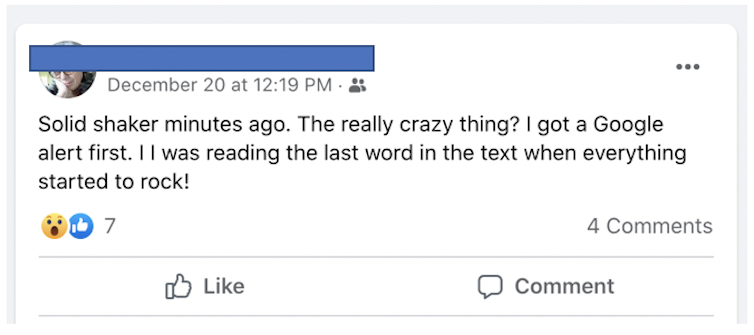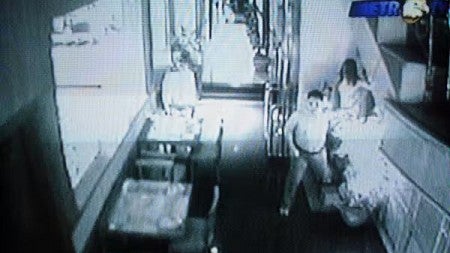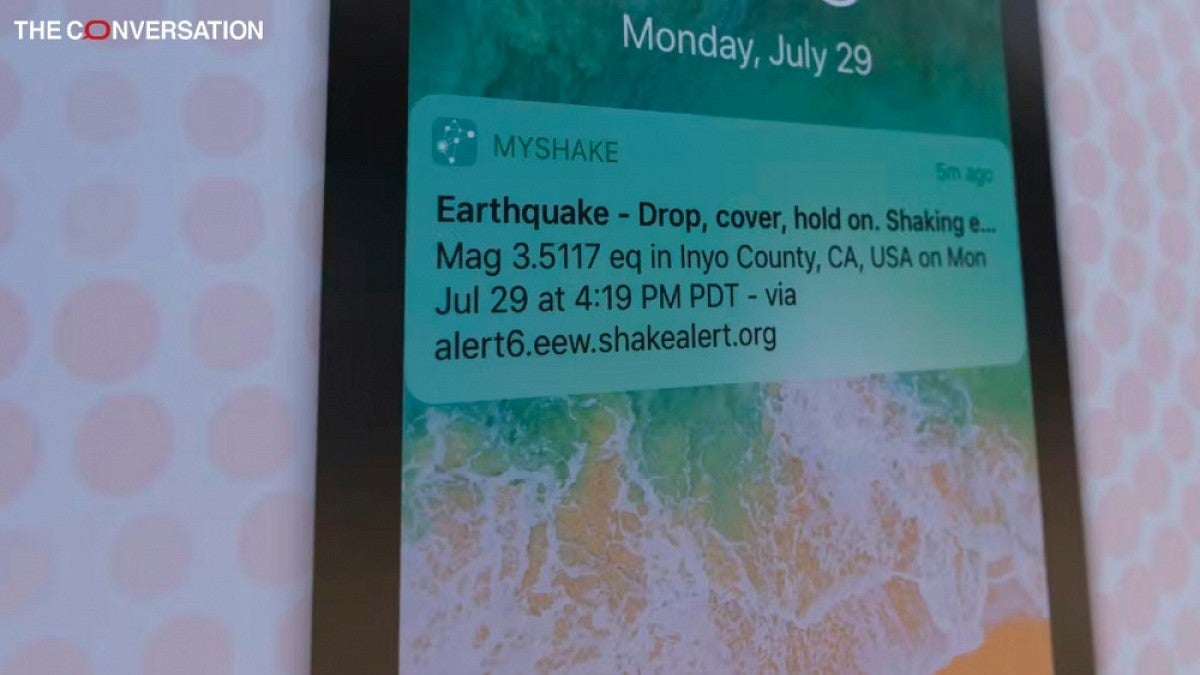Editor’s note: This article is republished as it appears in The Conversation, an independent news publisher that works with academics worldwide to disseminate research-based articles and commentary. The University of Oregon partners with The Conversation to bring the expertise and views of its faculty members to a wide audience. For more information, see the note following this story.
My Facebook feed exploded shortly after noon on Dec. 20, 2021, with news from friends and family in northern California: A “big one!” The 6.2 magnitude earthquake they’d just experienced had its epicenter on the coast near Petrolia.
Yet many social media posts weren’t focused on the earthquake itself, but rather the alert sent to cellphones seconds before – or, for some, just as – major shaking began.

The ShakeAlert system is a remarkable technology, years in the making. It has the potential to save tens of thousands of lives in areas where high-magnitude earthquakes occur by providing a few seconds’ warning, enough time for people to take basic safety precautions. Marvelous as it is, though, ShakeAlert saves lives only if people understand what to do when they receive such an alert, and do it.

Videos during the Petrolia-centered earthquake are the first we’ve seen of what people do – or don’t do – when they receive a ShakeAlert-powered alert. The footage suggests we have more work to do.
Detection and warning of imminent earthquakes
ShakeAlert depends on a massive network of seismic detectors distributed around the West Coast that pick up initial earthquake shaking.
For people near the epicenter, the time it takes to process the data and send an alert may mean it arrives just as, or possibly even seconds after, major shaking begins. Even this roughly simultaneous notice is valuable, as it helps people realize what is happening, which often isn’t obvious.
For those further away from a quake’s epicenter, an alert may arrive seconds, or even tens of seconds, before strong shaking. That’s enough time to automatically shut down or alter the operations of key systems – for example, to slow or stop trains, control equipment involved in delicate medical procedures, or electrical grids. It’s also enough time to prepare mentally, as well as to take potentially life-saving protective action.
To maximize your chances of coming out of a major earthquake alive and intact, most experts recommend in most cases – for California, Oregon and Washington – that you “Drop, Cover, and Hold On,” or DCHO for short. The alert message appearing on your cellphone reminds you what to do.
ShakeAlert is the only earthquake early warning system for the public in the U.S. It went live in Oregon in March 2021, and in May it expanded to the entire U.S. West Coast. The system sends alerts via a group of delivery partners. For instance, Google Android phones display alerts via their operating system. Depending where people live, they can install alert apps – MyShake, QuakeAlert USA or San Diego Emergency ShakeReadySD – to their smartphone. And the Federal Emergency Management Agency system that sends emergency messages like Amber Alerts also issues earthquake warnings.
Considerable prior research helped to shape the content conveyed in ShakeAlert-powered alerts, as well as key messaging that occurs right after alerts. Getting all of this right is crucial, and it’s still a work in progress.
What people do before and during quakes
Until recently, researchers have had to rely primarily on after-the-fact interviews or “Did You Feel It?” post-earthquake surveys to learn what people remembered doing during an earthquake.

There are a few encouraging exceptions, though. For instance, CCTV footage from the 2018 7.2 magnitude earthquake in Anchorage, Alaska, shows a teacher and students in one middle-school classroom collectively enacting DCHO immediately and flawlessly.
The Petrolia earthquake videos offer the first chance to see if ShakeAlert-powered messages change how people behave before, during and even after a major earthquake. So far, in the footage we’ve seen, people noticed the alert yet did nothing relevant to protecting themselves.
In fact, no one in any of these videos from Dec. 20 undertook “Drop, Cover, and Hold On” precautions, regardless of whether, or when, they received an alert. Many people just stayed where they were, showed the alert on their phones to others and excitedly watched as objects swayed and crashed to the floor.
Frozen in the face of an emergency
My colleagues and I are hoping that a better understanding of what people actually do during major earth shaking will suggest ways to tweak the alerts so they inspire people to take safer actions. It’s a big challenge because doing nothing when an earthquake begins appears to be very common.
A 2021 survey conducted in both Seattle and Sendai, Japan, found that stopping and staying put was the dominant response to major earth shaking, even though it puts people at risk of serious injury from falling or being hit by falling objects. There are several likely reasons.
A major earthquake is a novel experience for many people, and often they simply may not know what to do. In addition, there are potential barriers to carrying out “Drop, Cover, and Hold On.” Age, disability and high body mass can make dropping to the floor and getting under cover problematic, though there are inclusive ways to DCHO.
Even when people do know what to do in an emergency, evidence suggests they may feel self-conscious or embarrassed about taking action. Classic social science research points to how contagious it can be, in the face of a variety of emergencies, to do nothing, creating cascading paralysis for everyone present.
By dropping, covering and holding on right when you receive an alert, you might unleash similar protective action in others nearby, possibly saving them, as well as yourself, from injury or death. Seen that way, doing DCHO when you receive an alert – despite the potential for embarrassment – is actually a form of everyday heroism.![]()
—By Dare A. Baldwin, Department of Psychology and Clark Honors College


